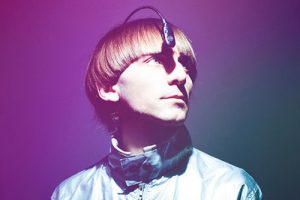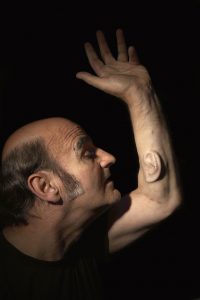Picture Teen Titan’s Cyborg’s multipurpose cybernetic arm cannon, Doctor Otto Octavius’ mechanical limbs, and the Winter Soldier’s vibranium arm. It seems crazy to imagine such scientifically accurate and effective pieces of technology, but in reality, they aren’t that far-fetched. In fact, many devices have been developed to substitute missing or impaired body functions, such as bionic limbs or wearable enhancements like exoskeletons to restore impaired movement. However, the building and successful implementation of these parts is no easy task. It takes the teamwork of experts from multiple fields and efforts from the patients to seamlessly integrate this technology into a patient’s body and life.
Giulia Dominijanni’s paper on the “Neural Resource Allocation” problem draws a line between body augmentation, the cognitive and physical improvement of a human, and robotic gadgets like remote controls. A common example would be limb prosthetics for the medically disabled, ranging from the most necessary functions such as joint movement to a USB port as a finger. Dominijanni focuses on methods for effective control of devices while maintaining the natural biological ways of movement. That way, the patient doesn’t compromise their autonomy or freedom of function. The balance between the two, however, is precarious. She mentions how the combined perspectives of “engineering and neuroscience with considerations from human-machine interaction, sensory-motor integration, ethics, and law” ensures successful augmentation. Dominijanni certainly doesn’t compromise skillfulness, but from a patient’s perspective, it would take months or even years to fully master the cognitive and motor controls, such as execution of tasks or eye coordination, not to mention the monetary cost. Considering this, would it even be worth it to shell out thousands of dollars for non-essential augmentations?
Enhancements and prosthetics are definitely expensive to develop and purchase, yet with more and more emphasis on the field come increased attention and normalization. In September of 2021, the new K. Lisa Yang Center for Bionics was established at MIT with a $24 million gift from philanthropist Lisa Yang. Bionics is the science of constructing artificial systems with characteristics of living systems. Scientists and engineers take inspiration from biology itself to create tech that could restore bodily functions, examples being “prosthetic limbs that effortlessly navigate tricky terrain to digital nervous systems that move the body after a spinal cord injury.” These advancements are crucial to the medically impaired, as the nervous system controls mobility and cognition through signal transmission from the brain to the rest of the body. The bionics center integrates knowledge from robotics, artificial intelligence, surgery, biomechanics, and design to focus mainly on three areas: a digital nervous system, brain-controlled limb exoskeletons, and bionic limb reconstruction. These areas could respectively eliminate movement disorders from spinal cord injuries, assist weak muscle and musculoskeletal disorders, and restore natural movement and touch. MIT’s focus on providing effective tech promises great opportunities if it can be harnessed correctly for people with disabilities.
Along with integrated body augmentation, exoskeletons are prominent mechanisms that humans can wear, like Iron Man’s robotic suit. Thibault, a 30-year-old quadriplegic, worked with researchers to develop a 140-pound exoskeleton suit controlled by his thoughts, with which he could walk and use his arms. Two implants were connected to parts of his brain controlling movement; subsequently, his brain waves were translated to a computer that could then send messages to the exoskeleton. Although the suit has only been tested while attached to a ceiling harness to avoid any potential accidents, the suit is “proof of concept that exoskeletons have the potential to eventually give paralyzed people more mobility,” which is an exciting revelation.
Interestingly, exoskeletons have also been the center of interest since 2016 for automaker companies such as Ford, BMW, Toyota, Hyundai, and Honda for their potential to reduce musculoskeletal injuries for workers and boost productivity. A Shanghai-based company called ULS Robotics develops wearable exoskeletons allowing workers to lift extra weight, which is useful along general assembly lines for industrial manufacturers like carmakers. This may seem excessive, but ULS Robotics’s founding partner Huang Mingming raises a good point: “While the auto industry is already highly automated, experienced workers are still needed for the final general assembly. That’s not replaceable.”
Wearable equipment can undoubtedly increase efficiency and productivity, but for researchers like Dr. Rosemarie D. Wesson and Dr. Hao Su, the two main challenges in balancing function with comfort have been the heaviness of the exoskeleton structure (electric motors, gears, etc.) and the misalignment of robotic and human joints. Dr. Su then developed lighter motors and bioinspired mechanisms that mimicked biological knee joints to minimize discomfort for the wearer. By reducing its mass and imitating the rolling contact between the femur and the tibia, it led to a more lightweight and smoother operation. Comfort is definitely the key here!
The Japanese brand Archelis also prioritizes comfort in their exoskeletal wearable chairs. They have products for both medical and industry workers to reduce fatigue from standing for long amounts of time when, for example, performing surgery. With occupations that demand long working hours and near-constant standing, these exoskeletons could not only boost productivity but could also provide healthy modifications for workers and decrease the health risks associated with strenuous work.

Another form of augmentation is cyborgization, which becomes a bit more complicated. These devices are directly implemented into the patient, meaning they can’t be taken off like prosthetics and exoskeletons. A popular example of a cyborg is Neil Harbisson, a Catalonian artist who has an antenna implanted into his skull that allows him to translate color into sound. This device initially helped him counter his achromatopsia, which is a form of color blindness that only allows sight in gray tones, but now Harbisson channels his creative visualizations from his “eyeborg” into his artworks and paintings. It specifically can detect a light’s hue and convert it into a frequency he can hear as a note. For example, “a telephone ring sounds green, while Amy Winehouse is red and pink,” and he can even perceive wavelengths in the infrared and ultraviolet range.

Another daring artist who has experimented with cyborgization is Stelarc and his “Ear on Arm” project, where a partially surgically constructed, partially cell-grown “third ear” is growing on his forearm. The ear was first implanted in 2006, when a “biocompatible scaffold,” made by reparative materials such as gelatin, collagen, and hyaluronic acid, was inserted into Stelarc’s left forearm to create the shape of an ear. When it becomes a more 3-D structure, he plans to insert a small microphone in between his teeth so that he can pick up a call and speak to them through his ear. That way, it would allow him to hear their voice in his head when they’re speaking, as the sound would reverberate in his mouth! Stelarc’s devotion to engineering and art is expressed through the medium of his own body, bringing creative ideas for how society can use bioaugmentation beyond medical needs.
Biological body augmentation is not just science fiction anymore, and it is coming into rapid fruition. However, there are still ethical considerations to this development, such as the ethics of how we treat cyborgization. Professor Steve Mann, a Canadian professor who wears a Google Glass-like headset with small computers, was a victim of the world’s “first cybernetic hate crime” in 2012 at McDonald’s, where employees tried to remove his “Digital Eye Glass” and destroyed his support documentation. Known as the “father of wearable computing,” Mann created it to aid in his vision and added computational functions such as photography and memory processing, which was how he captured images of the Mcdonald’s employees.
The interactive story game Detroit: Become Human also deals with the moral dilemmas of a robot race and its human counterparts. Throughout the story, the tension between the two becomes apparent as unemployed humans blame their unemployment on the androids, while the androids have to stand in separate compartments in the bus compared to their “human masters.” As Andrew Freedman puts it, “Detroit, on its surface, is tackling a near future in which humanity has created technology smarter and more capable than itself,” which in turn leads to violence. It is a dark reflection of the problems that we still face today and a possible extension of what could continue if mechanized humans are ostracized or discriminated against.
At the extreme, we could look forward to modernizing our own Marvel super squad and possibly normalizing the heavy use of biotechnology. From breathing underwater and dispatching our own group of supersonic mermaids to explore the Mariana Trench, to traveling further into space with our own Star Trek force, pushing the boundaries of exploration and the unknown seems to be right at our fingertips.
References:
https://wordpress.org/openverse/image/f01c4d08-9c63-480f-9e27-d1a128b8cb95
https://gizmodo.com/what-may-be-the-worlds-first-cybernetic-hate-crime-unfo-5926587
https://medicalfuturist.com/the-worlds-most-famous-real-life-cyborgs/
https://arxiv.org/ftp/arxiv/papers/2103/2103.17252.pdf
https://www.tomsguide.com/us/detroit-become-human,review-5447.html
https://www.nature.com/articles/s42256-021-00406-y
https://news.mit.edu/2021/new-bionics-center-established-mit-24-million-gift-0923
https://www.theguardian.com/artanddesign/2014/may/06/neil-harbisson-worlds-first-cyborg-artist
https://www.wired.com/2012/05/stelarc-performance-art/
https://www.gartner.com/en/information-technology/glossary/human-augmentation
https://www.autonews.com/manufacturing/exoskeleton-suits-turn-auto-factory-workers-human-robots

